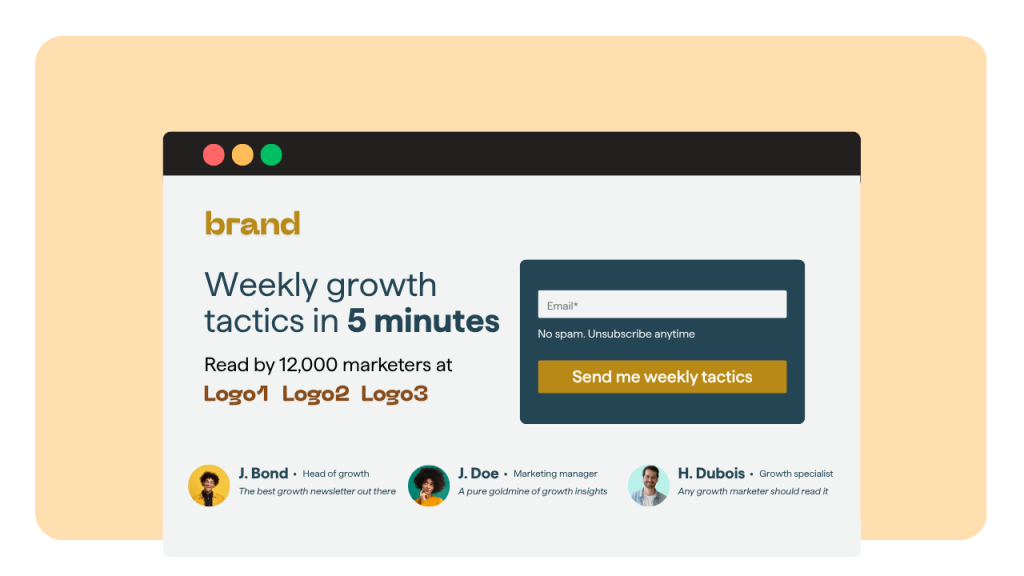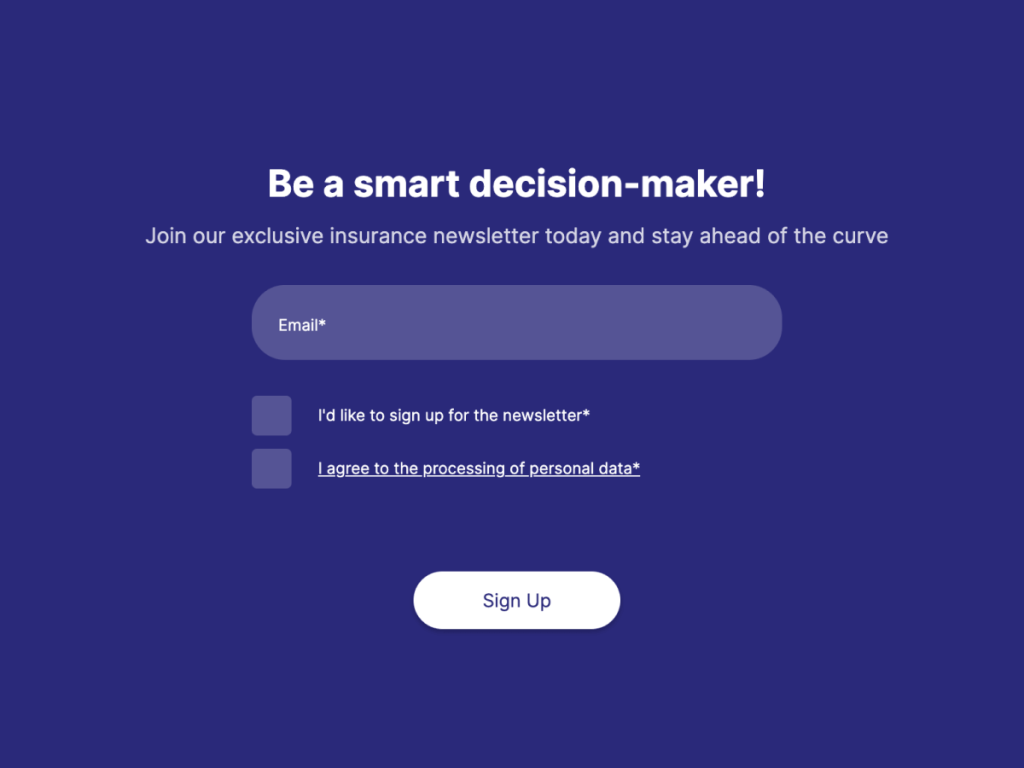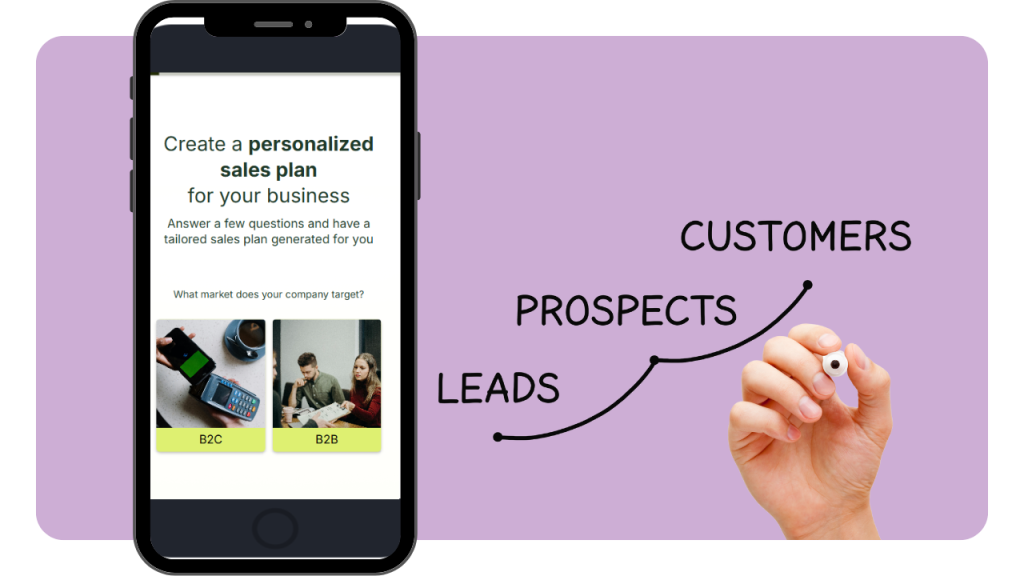You want more qualified subscribers for your newsletter, not random emails you never see again.
A focused landing page can do that, if you build it with intent.
The payoff is real, but there are a few things to take into consideration.
To start with, mobile now accounts for about 59% of global web traffic, so your page must load fast and communicate fast to earn the opt-in. Then, most people read less than you think. On average, visitors read 20 to 28% of the text on a web page, which means your offer and call to action need to do the heavy lifting fast.
In this guide, you will build a landing page for newsletter sign-ups that converts, in steps that fit any team size or industry.
Define Your Goal, Offer, and Success Metrics
Decide the One Action and One Audience
As you should almost always do with landing pages, start by defining one clear action you want from the user.
In this case, your landing page should ask for a single commitment: subscribe to your newsletter. Avoid extra links that compete with the form. When adding two or more competing CTAs, conversions often drop. You will see better results by focusing on one value exchange, like a weekly insight email in 5 minutes or less.
Pick one audience segment for the page. For example, busy marketing managers might want short, tactical tips, while founders want market trends, so you shouldn't target these 2 segments with the same landing page.
Use one audience and one promise per page to keep friction low.
Look at a recognizable example: Morning Brew scales by targeting concise business news and grew to over 6 million subscribers, which shows how a tight value proposition hooks a specific reader profile.
Pick the KPIs That Matter and Set a Target
Decide how you will measure success before you design. Track conversion rate on the page, completion time for the form, and new subscriber quality. For quality, monitor bounce rate and spam complaint rate from your ESP.
Set a numeric goal that is realistic. If you add a welcome pop-up to the same session, the average pop-up campaign conversion rate will be around 4.13%. Your landing page can beat those numbers because visitors arrive with intent. Set an initial target and a plan to test your way up by 10 to 20 percent over two sprints.
Win the Above-the-Fold: Value, Visual, and Single CTA
Clarify the Value in 10 to 15 Words
The top section must answer two questions fast:
What do I get?
How often will you email me?
Keep the headline crisp. “Weekly SEO growth tips in 5 minutes” is clear, short, and addresses the 2 questions.
Keep in mind that people scan pages in an F-shaped pattern, paying the most attention to the top and left areas, so place your headline and form there.
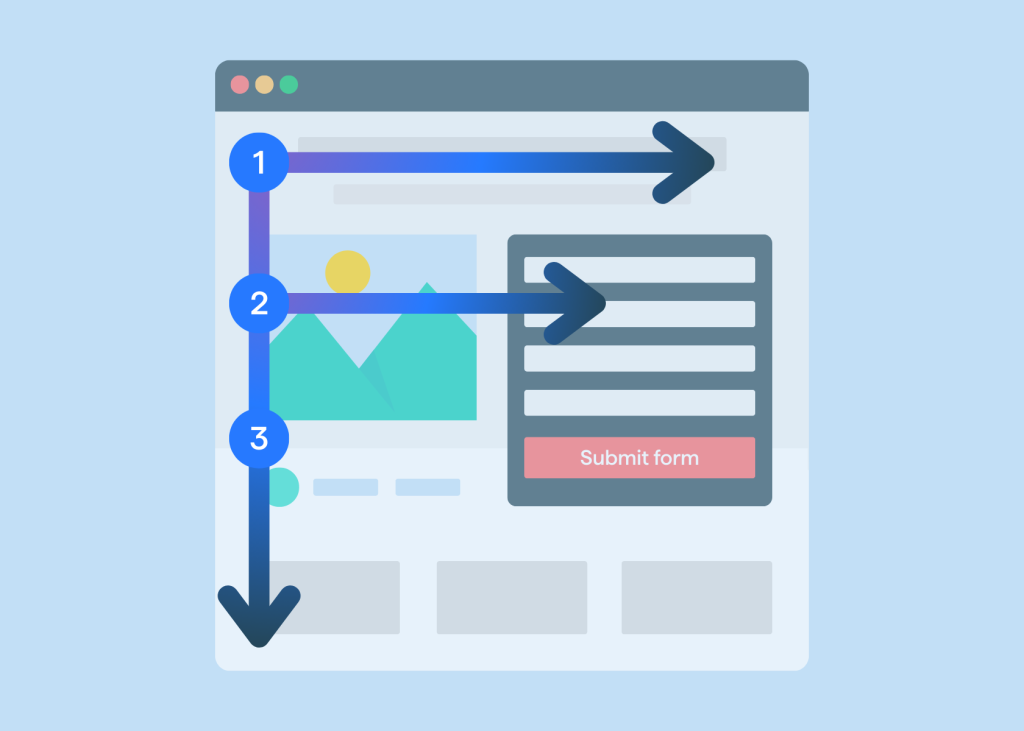
Add a subhead with one proof point. For example, “Trusted by 12,000 marketers” or “Read by teams at [3 logos].”
Users read a small fraction of your copy (about 20-28%), so each word must earn attention. Keep the first screen free of secondary links to reduce distraction.
Use One Primary Call to Action
Make the button text specific to the outcome. Replace the generic “Submit” with “Send me weekly tips.” Specific microcopy raises intent.
Keep the CTA above the fold and repeat once below. Use a button color with strong contrast against the background. For visual consistency, keep padding and size consistent across viewports.
Include one short reassurance line near the button. Try “No spam. Unsubscribe anytime.” This reduces anxiety about inbox clutter. Keep it short: 5 to 10 words.
In parallel, test a variation that adds frequency, like “One email, every Wednesday.” You can score quick gains of 5 to 10 percent in clicks with clearer button labels, though results vary by audience, so run an A/B test.
In Summary | |
Headline | Promise the outcome, not the process |
Subhead | Add proof or clarify frequency |
CTA | Make the action specific, benefit-led |
Reassurance | One short line near the button |
Review that list with your team and decide on a first version. Then set a simple test plan to validate your assumptions over the next two weeks.
Design a Low-Friction Form
Ask for the Minimum and Use Smart Defaults
Before you add a fifth field to your form, remember this: every extra field is a decision point for the user, and every decision point increases the chances that the user will drop off.
Fewer fields reduce friction and speed up completion.
If you can, start with only an email field. If you need segmentation, add one optional field like job role.
Avoid phone number for a newsletter form unless you have a clear SMS plan. If you must collect a first name, mark it optional (you can still ask for it later).
Then, make it as easy as possible for the user to correctly fill in the form:
Use inline validation and clear error messages. Show an error as soon as the email format is invalid, and say exactly what to fix.
Place the label above the field for better accessibility and scanning.
Keep the form width comfortable on mobile and test thumb reach. Mobile traffic is about 59 percent of global visits, so prioritize a clean one-column layout on small screens.
Cut Friction with Autofill and Visible Privacy Text
Enable browser autofill for email and name by using standard input names. This saves a few seconds per user and reduces typos.
Add a short privacy note right under the form fields. Keep it short. For example, “We use your email to send the newsletter and nothing else.” Link to your full privacy policy near that note.
Place the checkbox for consent only when you legally need it. When in doubt, add it. Under GDPR, you need clear, affirmative consent for marketing emails, and pre-checked boxes do not count. Respecting consent is not just a legal box-tick. It protects your sender reputation and reduces spam complaints.
In Summary | |
Fields | Email only to start, one optional field at most |
Validation | Inline checks and specific error text |
Autofill | Standard input names and attributes |
Privacy | One clear sentence plus a link to policy |
Use that checklist as your baseline. Then observe your form analytics to see where people drop off and iterate.
Strengthen Trust With Social Proof and Clarity
Use Proof People Understand Fast
Humans copy what others value.
So add logos of well-known readers, short testimonials, or subscriber counts near the fold. Keep numbers credible and dated where possible. The goal is to reduce second thoughts in the first 5 seconds.
For ecommerce, showing reviews can increase conversions by up to 270%, which shows the broader power of social proof cues on decisions.
Use one tight testimonial that supports the outcome. For example, “These tips helped us add 2 qualified demos a week.”
Add a name and company
Avoid long blocks of text because users scan
Limit testimonials to 15 to 25 words and show a maximum of three on the page
Test the placement right under the CTA and again near the footer
Reduce Anxiety About Inbox Load and Spam
Add one sentence that sets expectations on cadence and content: “Weekly, ad-free, practical growth notes.” Short copy eases hesitation.
You can also add a visible “unsubscribe anytime” line. These cues work because they lower perceived risk, which is key when users read only 20 to 28% of your copy.
Highlight your data practices briefly. Link to your policy and add a contact for questions. Under CAN-SPAM, you must include a valid physical address and a working unsubscribe in every email, so reflect that standard in your promise on the page. Clear expectations improve trust and long-term list health.
Logos or counts: only if accurate and current.
Testimonials: 1 to 3, short, with names.
Cadence copy: explicit frequency and content type.
Policy link: near the form with simple language.
Review your current proof. Cut anything that is vague or dated, and keep only what a skimmer can understand in 3 seconds.
Speed, Mobile Experience, and Core Web Vitals
Faster Pages Convert More and Bounce Less
Speed is money. A Portent study found that conversion rates are highest between 0 and 2 seconds and drop sharply as load time increases. They measured big declines as pages slow from 1 to 5 seconds, with the most dramatic drop early. Aim for 2 seconds to first visual and under 2.5 seconds for Largest Contentful Paint.
Meet Core Web Vitals thresholds to protect organic reach. Google recommends:
Largest Contentful Paint (LCP) under 2.5 seconds
Cumulative Layout Shift (CLS) under 0.1
Interaction to Next Paint (INP) under 200 milliseconds is a good user experience.
Google also uses these metrics in Search ranking systems, which means poor vitals can cost you traffic.
Optimize Media and Layout for Mobile-first Visits
Assume most visitors are on mobile. In many regions, mobile already exceeds 60% of traffic, and worldwide it sits around 59%.
For images:
Keep the hero image under 200 KB
Lazy-load below-the-fold images
Serve responsive images with srcset.
Compress images and use next-gen formats like WebP
Use system fonts or a small subset to reduce blocking. If you don't want to use system fonts, preload your web fonts.
As for the layout:
Prioritize a one-column layout
Use large tap targets
Keep buttons at least 44 by 44 pixels
Test form field focus and auto-advance between fields
Use a sticky CTA on long pages so users can act without scrolling back
Other optimizations:
Measure time to interactive and scroll depth so you can spot friction earlier
Inline critical CSS and defer non-critical scripts
Limit third-party scripts to essentials
Run these checks with each release. Your conversion rate depends on how fast you deliver that first meaningful paint and interaction.
Consent, Double Opt-In, and Deliverability
Collect Consent the Right Way
If you serve or market to the EU, get explicit consent for marketing emails. GDPR requires clear, affirmative opt-in and bans pre-checked boxes for consent. Link to your privacy policy and provide a real contact for data questions. If you use tracking cookies or pixels, consider ePrivacy and local rules as well.
In the United States, CAN-SPAM requires a valid physical address and an easy unsubscribe link in every email, and you must honor opt-outs within 10 business days.
Reflect these rules in your on-page copy. The goal is simple: make the promise on the page match the behavior in your emails.
Decide Between Single and Double Opt-in
Single opt-in collects more emails fast.
Double opt-in collects cleaner emails and protects engagement.
Mailchimp notes that double opt-in can reduce bounces and spam complaints, since subscribers confirm from their inbox before joining your list. That can improve inbox placement, which pays off over time.
For high-risk traffic sources like paid social or sweepstakes, use double opt-in to protect sender reputation. You can test a hybrid approach if you must. For example, use single opt-in for high-intent organic traffic and double for paid campaigns.
Show consent text near the form.
Use double opt-in for colder sources.
Send the confirmation email within 30 seconds.
Add a clear unsubscribe to every message.
Revisit this policy quarterly. As sources change, your opt-in model may need a tune-up to stay under key thresholds.
Test Like a Scientist and Measure What Matters
Pick High-impact Tests First
Not all tests are equal. Start with elements that change clarity or friction. That means headline, CTA copy, form length, and proof placement.
Avoid tiny color tweaks until you have wins on clarity. Aim for changes that can move conversion by 10% or more, so you can detect results with smaller samples.
Design your tests with a sample size in mind and use a calculator to avoid calling results too early. A widely used resource is Evan Miller’s A/B test sample size calculator, which will help you set a needed sample and duration based on your baseline and desired lift.
Run tests for at least one full business cycle to catch day-of-week effects.
Track Beyond the Submit Click
Measure the full path.
Tag the submit event, the error rates per field, and the confirmation page view.
Track welcome email opens within 24 hours for new sign-ups and monitor spam complaint rates by source UTM.
Keep a dashboard with conversion rate, average time on page, and completion rate. Review it weekly.
Too many teams stop at the button click. You need to check that subscribers confirm, open, and click the welcome email. If your double opt-in confirmation click rate is under 60%, review your confirmation email subject line and preheader. Keep the subject to 30 to 45 characters for mobile readability.
Plan tests by impact and clarity, not novelty.
Use a calculator to set sample size and duration.
Track submit, errors, and confirmation events.
Review weekly and keep a changelog.
This discipline compounds. Each confident win stacks on the last, and you avoid noisy changes that waste traffic.
Add Pop-ups, Slide-Ins, and Exit-Intent the Right Way
Use Secondary Surfaces to Catch Leaving Visitors
Not everyone will convert on the page. Give them a second chance with a simple pop-up or slide-in.
Keep the headline short and the offer clear.
If you add a timed pop-up, wait at least 10 seconds or set it to trigger on 50% scroll.
Make dismissing easy on mobile to avoid annoyance.
Benchmarks help set expectations: A study of nearly two billion pop-ups found an average conversion rate of 3.09%, with the top 10% hitting 9.28% or higher.
Use this to estimate added sign-ups from a pop-up. Then test the creative and triggers to see if you can reach the top tier.
Keep the Message Consistent and Focused
In terms of copy:
Match the pop-up offer to the page. If your landing page offers weekly SEO tips, keep the pop-up offer the same or narrower.
Avoid bait-and-switch copy, make it tight and benefit-led.
On exit-intent, try a softer save. “Want the weekly version to review later?” is a helpful nudge
For the form:
Keep the form to one field on the pop-up.
Add the same privacy cue you use on the page to set expectations.
Track and Adapt
Track pop-up conversion rate and net subscriber quality by source. If popup subscribers churn faster or complain more than 0.1%, adjust or remove the popup for that segment.
The goal is to use popups to recover leaving visitors without hurting list quality. If quality drops, dial back frequency or switch to a sticky bar.
In Summary | |
Copy | Tight, benefit-led, and consistent with the page |
Form | One field, with inline validation |
Trigger | Time delay, scroll depth, or exit-intent |
Quality check | Monitor unsubscribes and complaints by source |
Accessibility and Readability Pay Off
Design for Everyone and Meet WCAG Basics
Accessibility is reach. About 1.3 billion people, or 16% of the world’s population, experience significant disability, which affects how they navigate and read on the web. Meeting core accessibility guidelines makes your page easier for everyone.
Follow WCAG 2.1 AA basics for contrast, focus, and semantics:
Aim for a contrast ratio of at least 4.5 to 1 for body text
Use proper labels on inputs, visible focus states, and meaningful button text
Add aria-live to inline error messages so screen readers announce them
Write for Scanning, Not Study
Users are busy; they skim content. They read 20 to 28% of your words on average, so tighten copy and break it up with white space.
Use short sentences, one idea per paragraph, and bullets for lists of three or more items. Keep your reading grade level around eighth grade for broad comprehension.
Place your most important words first in headlines and CTAs. For example, “Get 5-minute growth tips weekly” beats “Subscribe to our newsletter.”
As a reminder, people follow the F-shaped scanning pattern, so front-load key terms where eyes land first. That small change can lift clarity in seconds.
In Summary | |
Contrast | At least 4.5 to 1 for body text |
Labels | Explicit and programmatically tied to inputs |
Focus | Visible and keyboard accessible |
Copy | Short, front-loaded, and skimmable |
Accessibility is a conversion win and an ethics win. It broadens your audience and reduces friction for everyone.
Examples That Pull It All Together
Newsletter Landing Page Example Flow
Let’s walk through a practical example where you run a weekly marketing newsletter:
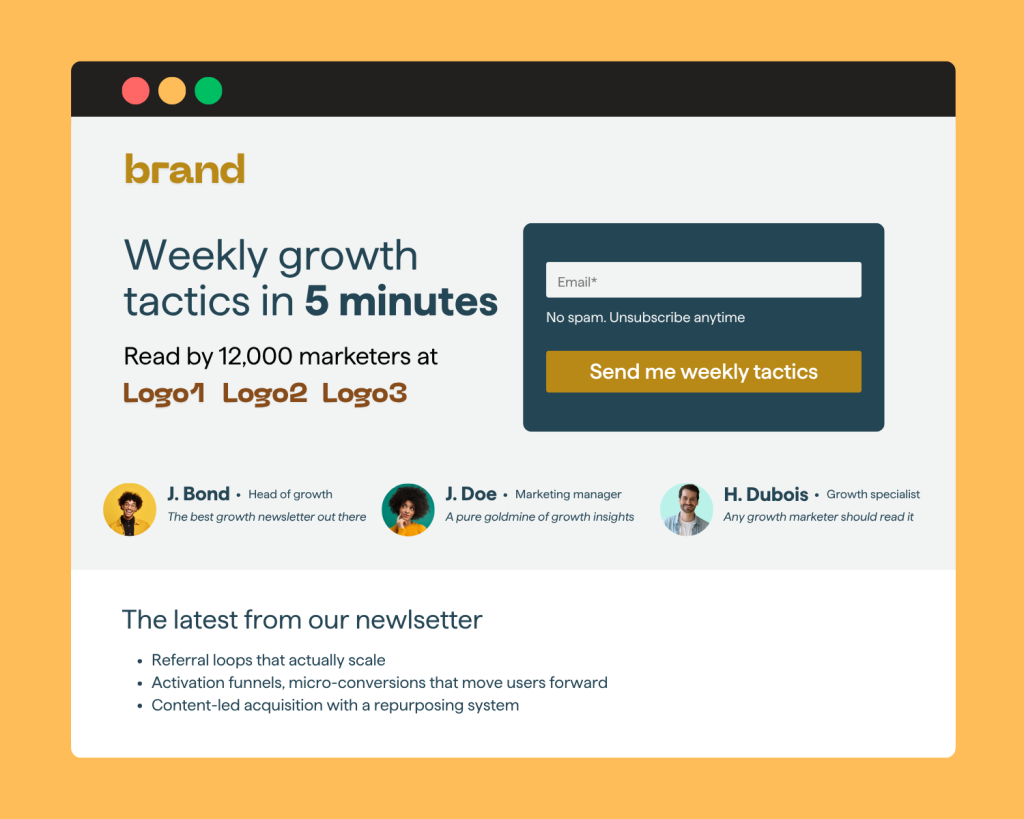
The headline reads “Weekly growth tactics in 5 minutes.”
The subhead says “Read by 12,000 marketers at [3 logos].”
The form asks only for email, with inline validation, and a CTA button that reads “Send me weekly tactics.”
You include a privacy line, “No spam. Unsubscribe anytime.”
Below the fold, you add three short testimonials with names and roles
You include a short section that shows the last three topics from your newsletter.
The page loads in 1.6 seconds on a 4G mobile test and passes Core Web Vitals with LCP at 2.2 seconds, CLS at 0.02, and INP at 180 milliseconds.
You cap it with a clean footer and no extra navigation links.
How involve.me Can Help You Build High-Converting Landing Pages
All the best practices above can be followed easily with involve.me’s all-in-one landing page builder. The platform is built to help you create, publish, and optimize a newsletter sign-up page that converts:
No-Code Builder & High-Converting Templates
involve.me offers a drag-and-drop page builder with 300+ pre-designed templates (including dedicated newsletter sign-up forms), alongside a powerful AI agent that acts as a personal funnel expert. So you can launch a professional, conversion-optimized page fast. No coding is required, and you can fully customize the layout, text, and visuals to match your brand.
This means your sign-up page can be up and running in minutes, not weeks, without sacrificing quality. In fact, we report 15× higher conversion rates on its interactive pages compared to static pages.
Get started with a template

Newsletter Signup Form For Agency Client Template
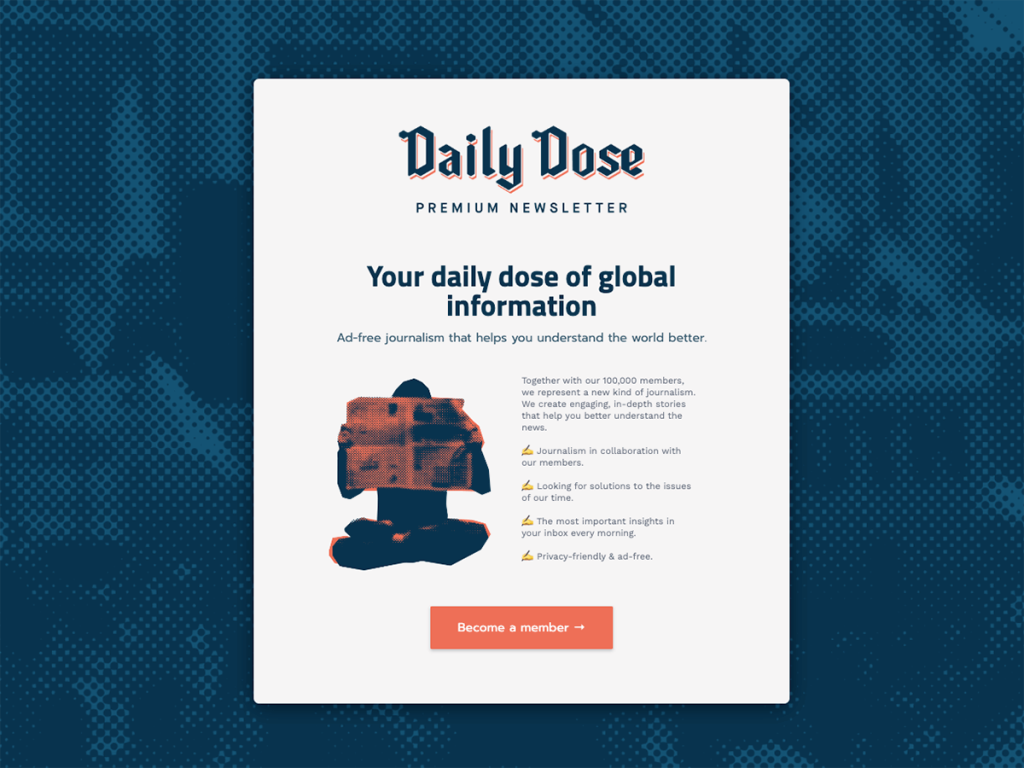
Premium Newsletter Subscription Template
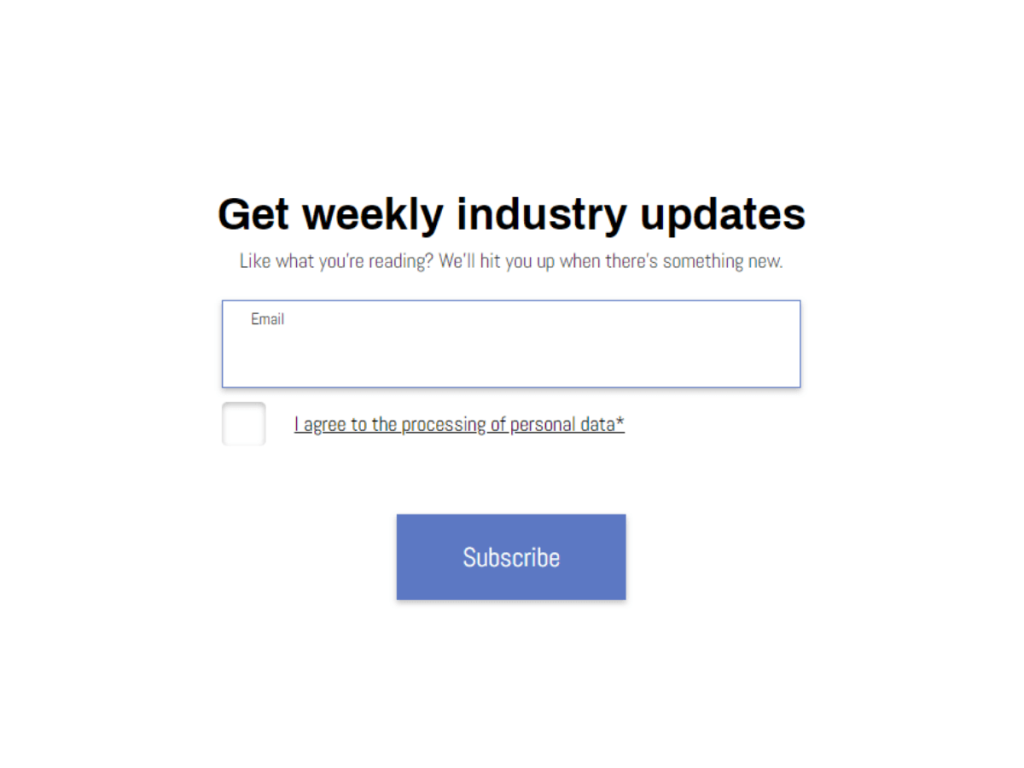
Subscribe To Newsletter Template

Newsletter Sign-up Form for Online News Template
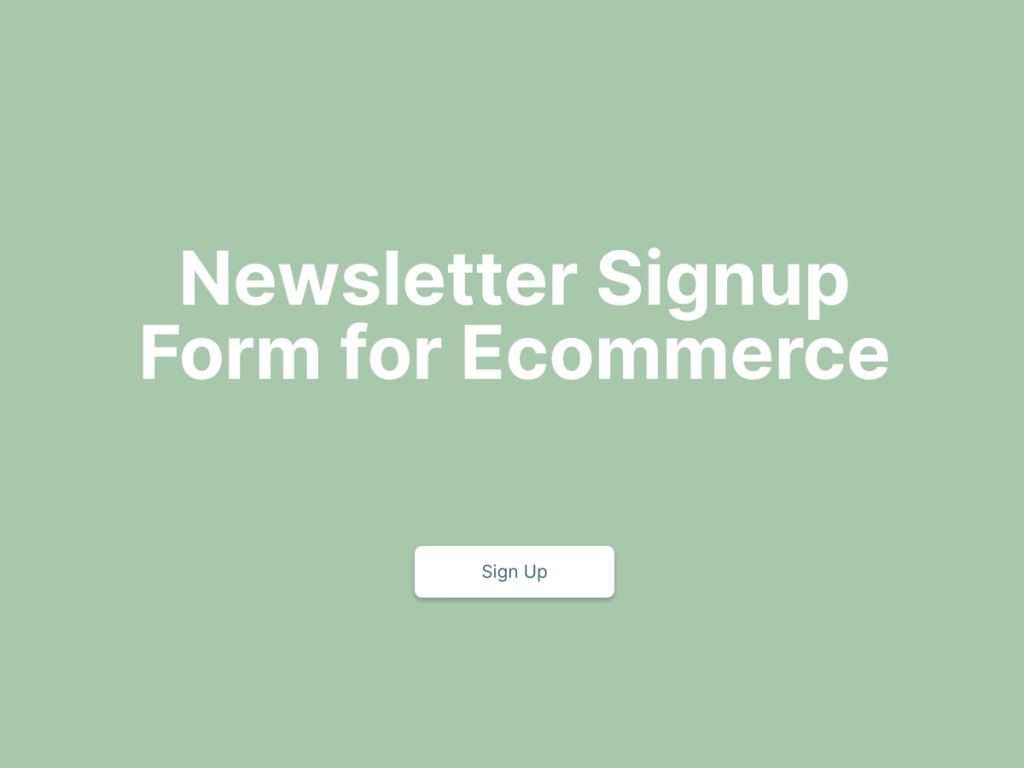
Newsletter Signup Form for Ecommerce Template
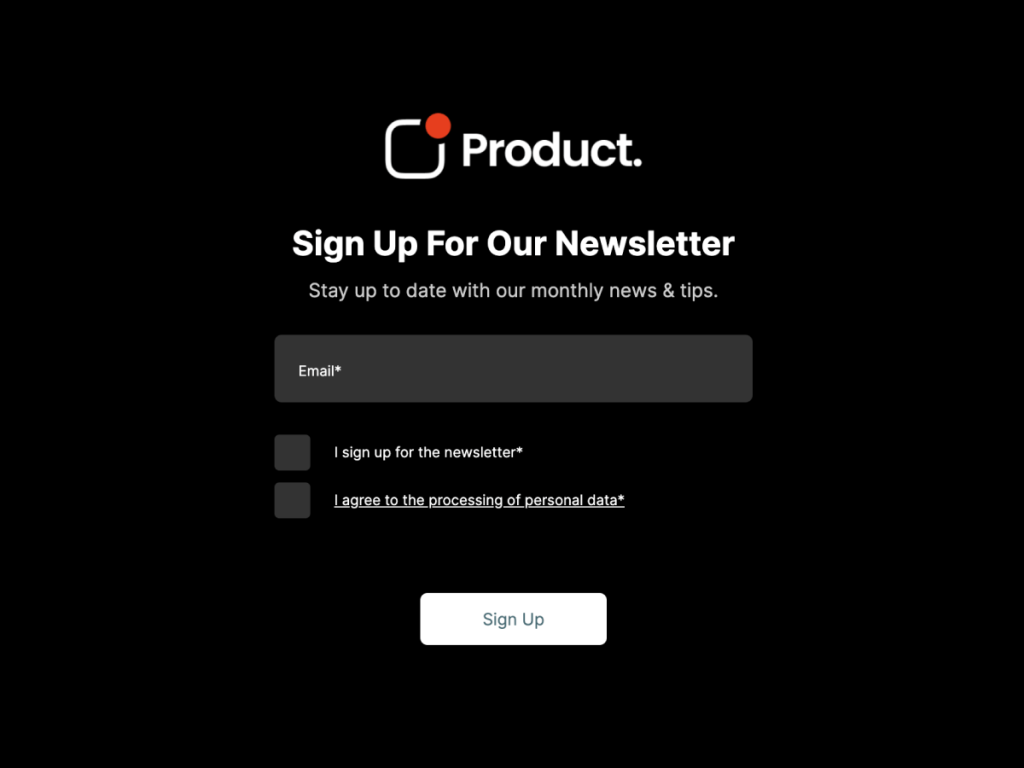
Newsletter Signup Form for Software Template
Newsletter Signup Form for Insurance Template
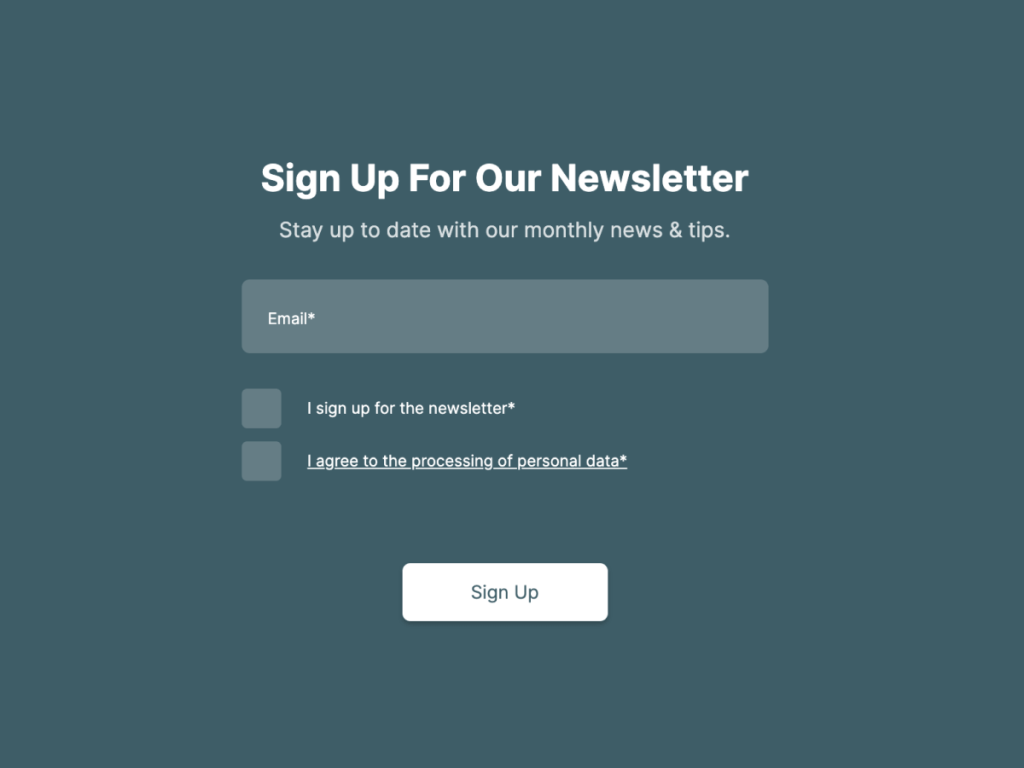
Newsletter Signup Form for Real Estate Template
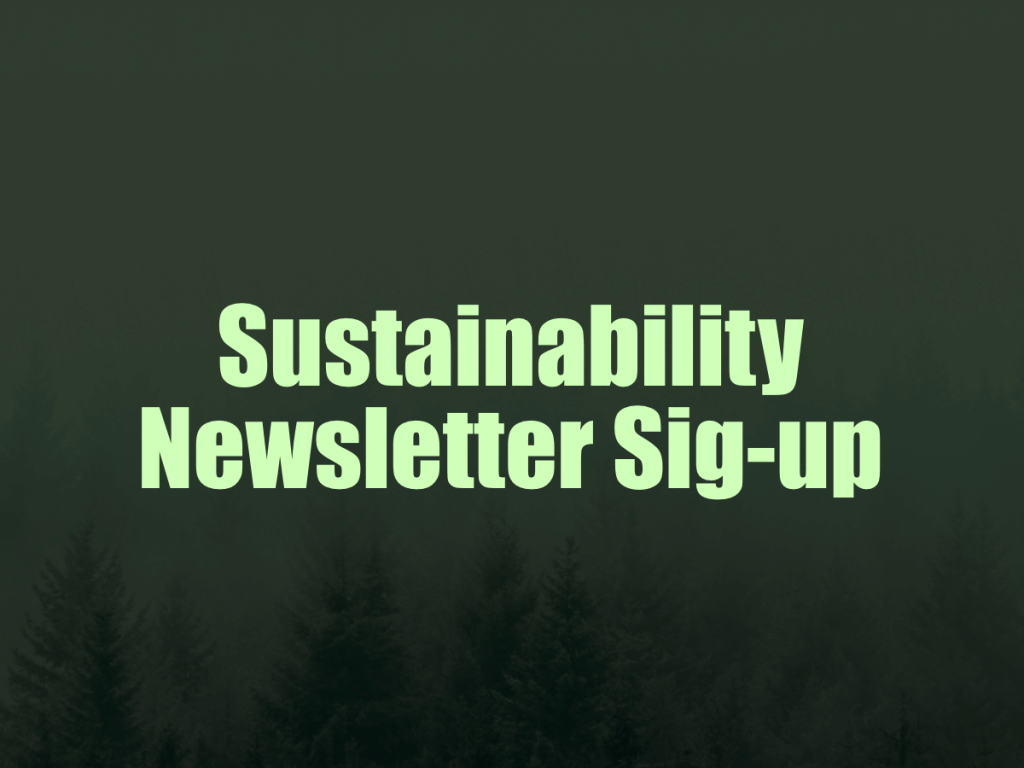
Sustainability Newsletter Sign-up Template
Mobile-Optimized & Flexible Publishing
Pages built with involve.me are mobile-responsive by default and load quickly, meeting the needs of today’s mostly-mobile visitors.
You can publish your newsletter sign-up page on a custom domain or let involve.me host it for you, and even embed the form on your own website or trigger it as a pop-up to catch visitors before they leave.
This flexibility lets you present your offer wherever your audience is, without worrying about technical setup or performance on different devices.
Seamless Email & CRM Integration
Every new subscriber can flow directly into your email marketing platform or CRM, thanks to 60+ native integrations (and 2,000+ more via Zapier) with services like Mailchimp, ActiveCampaign, HubSpot, and others.
In other words, involve.me can automatically add sign-ups to your mailing list and initiate your welcome or drip sequence immediately when someone subscribes.
This saves you manual work and ensures each subscriber gets a timely follow-up (such as a double opt-in email or a welcome message), which, as we noted, increases the likelihood of turning a casual visitor into an engaged subscriber.
Built-In Analytics & A/B Testing
Involve.me tracks all the important metrics for you: views, click-through rates, form drop-offs, conversion rates, and more, in a real-time dashboard. You can see how long people spend on the page and where they might be hesitating.
The platform also includes integrated A/B testing, allowing you to clone your page and test variations of headlines, offers, or CTA buttons to statistically determine which version converts best.
This data-driven approach means you can continuously improve your page’s performance (e.g. run experiments on that headline or button copy we discussed) without needing external tools.
Multi-Step Funnels & Personalization
Unlike a static one-page form, involve.me lets you easily create multi-step sign-up funnels or even mini-quizzes that guide users through a personalized journey.
For example, you could ask one quick question before the email field (such as an interest or preference) to better segment your newsletter audience.
By breaking the sign-up process into smaller, engaging steps, or tailoring the content to a visitor’s answers using logic jumps, you reduce friction and capture more qualified leads. Users feel the experience is more relevant, and as a result, these interactive funnels tend to yield higher quality leads and conversion rates than a one-and-done form.
Trust and Compliance by Design
involve.me includes features to build trust and stay compliant with ease. You can add an opt-in consent checkbox (for GDPR/email permission) and a Google reCAPTCHA challenge in one click. Many of involve.me’s signup form templates have these elements ready out-of-the-box. Such features reassure users that their info is safe and help keep bots out.
You can even block disposable emails or free email domains if you prefer to collect business addresses only.
All data collection is GDPR-compliant by default on involve.me, and you have options to include privacy policy links or disclaimers, so you can grow your list responsibly while maintaining your sender reputation.
Bottom Line
involve.me provides an end-to-end solution to design, optimize, and integrate your newsletter sign-up landing page. By leveraging its templates, integrations, and analytics, you’ll implement the best practices from this guide with a lot less effort and see more of your visitors turn into subscribers. It’s a fast, code-free way to create a high-converting newsletter landing page that you can continually refine into a top performer.
Build a newsletter sign-up page in minutes
Try involve.me for free and see how a well-designed landing page can considerably improve your sign-up rates.
Sources
Desktop vs Mobile vs Tablet Market Share Worldwide - statcounter
How Little Do Users Read? - NN Group
Do Popups Still Work in 2025? Here’s What The Data Tell Us (Original Research) - Sleeknote
Understanding Core Web Vitals and Google search results - Google Search Central
CAN-SPAM Act: A Compliance Guide for Business - Federal Trade Commission
About Double Opt-in - Mailchimp
Disability - World Health Organization
Contrast (Minimum) (Level AA) - Web Accessibility Initiative

